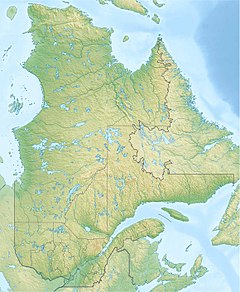Fishing
The Véco River is used as a spawning ground by Atlantic salmon (Salmo salar) and brook trout (Salvelinus fontinalis). Arctic char (Salvelinus alpinus) has been noted in Robertson Lake, and could be more widespread in the area. The mouth of the Véco River in Ha!Ha! Bay is home to rainbow smelt (Osmerus mordax), Atlantic tomcod (Microgadus tomcod) and American eel (Anguilla rostrata).
The Pourvoirie Kecarpoui arranges fishing/camping expeditions that include the Véco River and other nearby rivers (Kécarpoui, Saint-Augustin, Coxipi, Chécatica and Napetipi. In the period from 2012 to 2016 an average of four salmon were reported caught in the river each year. In 2017 all salmon, large and small, had to be released on the Malbaie (Gaspé Peninsula), Pigou, Bouleau, Magpie, Coacoachou, Nétagamiou, Little Mecatina and Véco rivers. Only young salmon could be retained on 51 rivers, and limited retention of large salmon was allowed on 19 rivers.
The Pigou River is a salmon river in the Côte-Nord region of Quebec, Canada. It empties into the Gulf of Saint Lawrence.
The Étamamiou River is a river in the Côte-Nord region of Quebec, Canada.

The Nétagamiou River is a salmon river in the Côte-Nord region of the province of Quebec, Canada. It empties into the Gulf of Saint Lawrence.
The Little Mécatina River is a major river in the Côte-Nord region of the provinces of Labrador and Quebec, Canada. Studies have been made to exploit the hydroelectric potential of the river, which could be around 1,200 MW from three dams. The Little Mécatina River was driven first with kayaks by Rolf Theiß and Fritz Gottensrtöter from Guetersloh, Germany.
The Gros Mécatina River is a salmon river in the Côte-Nord region of Quebec, Canada. It empties into the Gulf of Saint Lawrence.
The Coacoachou River is a river in the Côte-Nord region of Quebec, Canada.
The Gros-Mécatina Migratory Bird Sanctuary is a protected area in Quebec, Canada. It consists of four islands and a reef in the Gulf of Saint Lawrence that are used as nesting sites by seabirds.
The Lac-Robertson Generating Station is a 21.6 MW hydroelectric power station in east of the Côte-Nord region of Quebec, Canada. It supplies power to the local communities, and is not connected to the main grid.
The Kegaska River is a salmon river flowing on North shore of Estuary of Saint Lawrence. It crosses the unorganized territory of Petit-Mécatina, in the Le Golfe-du-Saint-Laurent Regional County Municipality, in the administrative region in the Côte-Nord, in the province of Quebec, Canada.
The Chécatica River is a salmon river in the Côte-Nord region of Quebec, Canada. It empties into the Gulf of Saint Lawrence.
The Belles Amours River is a salmon river in the Côte-Nord region of Quebec, Canada. It empties into the Gulf of Saint Lawrence.
The Saint-Paul River is a river on the Labrador Peninsula of eastern Canada. Its source is located in the province of Newfoundland and Labrador and it empties into the Gulf of Saint Lawrence in the Côte-Nord region of Quebec. The Saint-Paul River is a salmon river that flows in a southerly direction.

The Saint-Augustin River is a salmon river in the Côte-Nord region of Quebec, Canada. It empties into the Gulf of Saint Lawrence.
The Napetipi River is a salmon river in the Côte-Nord region of Quebec, Canada. It empties into the Gulf of Saint Lawrence.
The Coxipi River is a salmon river in the Côte-Nord region of Quebec, Canada. It flows south through Quebec from Labrador and empties into the Gulf of Saint Lawrence.

The Kécarpoui River is a salmon river in the Côte-Nord region of Quebec, Canada. It flows south and empties into the Gulf of Saint Lawrence.
The Musquanousse River is a salmon river in the Côte-Nord region of Quebec, Canada. It flows south and empties into the Gulf of Saint Lawrence.
The Washicoutai River is a salmon river in the Côte-Nord region of Quebec, Canada. It flows south and empties into the Gulf of Saint Lawrence.
The Ha! Ha! River constitutes the outlet of the Plamondon Lake reservoir, flowing in the municipalities of Côte-Nord-du-Golfe-du-Saint-Laurent and Gros-Mécatina, in the Le Golfe-du-Saint-Laurent Regional County Municipality, in the administrative region of Côte-Nord, in Quebec, in Canada.
The Baie des Ha! Ha! is located in the municipality of Gros-Mécatina, in the Le Golfe-du-Saint-Laurent Regional County Municipality, on the north shore of Gulf of Saint Lawrence, in the administrative region of Côte-Nord in eastern Quebec, Canada.
This page is based on this
Wikipedia article Text is available under the
CC BY-SA 4.0 license; additional terms may apply.
Images, videos and audio are available under their respective licenses.



